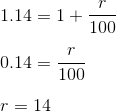This page is part of my unofficial solutions manual to the GRE Paper Practice Book (2e), a free resource available on the ETS website. They publish the questions; I explain the answers. If you haven’t worked through the Practice Book, give Section 5 a shot before reading this!
5.13: Simple Interest
In word problems like 5.12 (and 6.13 in the next section), we need to come up with our own ad hoc equation. This time, however, there’s a ready-made formula we can apply. Simple annual interest problems are fairly common on the GRE, so the formula for solving them is well worth committing to memory:
- V is the final value of the investment
- P is the principal (the amount initially deposited)
- r is the interest rate
- t is the number of years that interest accrues
Note that we needn’t worry about converting r from percent to decimal — the formula does that for us. So if a question mentions a simple annual interest rate of 5%, the correct value of r is 5, not 0.05.
Reading through the problem stem, we can identify three of the variables we need to complete the interest formula:
- P = $6,000
- V = $6,840
- t = 1
Only r — the value for which we’re supposed to solve — is missing. Plugging in our values of P, V, and t gives the following:
From there, we follow Thoreau’s advice and “simplify, simplify”:
Because r = 14, the correct answer is (D).
Sanity check: the final value V represents both principal and interest, so if we subtract out the principal P, we’re left only with the interest paid:
$840 is more than 10 percent of $6000, so we’d expect our answer to be larger than 10. Thus, even without working the problem in its entirety, we can rule out answers (A) and (B) as too small.
Math Review Reference
For more on this topic, see the following section of the GRE Math Review:
- 2.7: Applications (p. 28)
